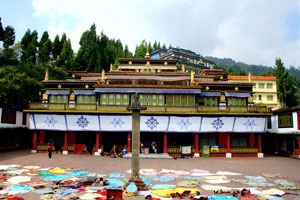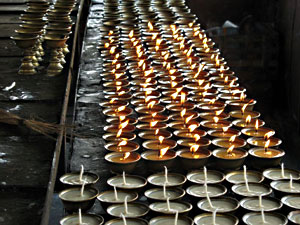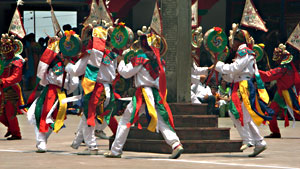|
|
|
Rumtek
Monastery, Sikkim |
|
|
|
Rumtek Monastery
The Rumtek monastery or the Dharma Chakra Centre is
located on the top of the hill facing the city of
Gangtok. Rumtek Monastery is one of the most important
seats of the Kagyu lineage outside Tibet. This monastery
complex embodies the vision and aspiration of the
Sixteenth Karmapa, Rangjung Rigpe Dorje, to establish
his seat-in-exile in order to spread the teachings of
the Buddha throughout the world. The Rumtek monastery is
the largest monastery in Sikkim, and a home of the monks
community. The complex has many sacred objects. One of
the most magnificent object is the Golden Stupa, which
|
 |
|
|
contains the
precious relics of His Holiness, the Sixteenth Karmapa. A
college or Karma Shri Nalanda Institute for Higher Buddhist
Studies is situated opposite the building. The Stupa walkway
surrounds the Rumtek monastery, where monks, pilgrims and
visitors perform kora. The Dharma Chakra Center includes a
beautifully structured main shrine temple and monastery with
monks' quarters, a three-year retreat center, a monastic
college, where the relics of the Sixteenth Karmapa are
enshrined, nunnery, stupas, a protector's shrine, institutions
for the lay community and other establishments. The Rumtek
monastery became the international Kagyu Headquarters during
the life of His Holiness and became the residence of a new
generation of Kagyu masters.
Location of the Rumtek Monastery
Dharma Chakra Center also known as the Rumtek Monastery is
located in eastern Sikkim, 24 kilometers away from Gangtok.
Rumtek is situated at an altitude of about 5800 feet (1547
metres). The best season to visit this monastery is from March
to late May, or from October to mid-December.
History of Rumtek Monastery
In 1959, His Holiness the Sixteen Gyalwa Karmapa fled from
Tibet after the communist Chinese invasion. After arriving in
Bhutan, he received a formal invitation from the Choegyal
(Dharma King) of Sikkim. The Choegyal Tashi Namgyal and royal
family of Sikkim had a long-standing connection with the
successive lines of Karmapas. The royal family eventually
decided to offer permanent residence for His Holiness and his
party in Sikkim. His Holiness accepted the Choegyal's
invitation to set up his main exile seat in Sikkim. On the
twenty fifth day of the fourth month of the year 1959, His
Holiness and the party arrived in Gangtok. Of the several
sites proposed by Choegyal Tashi Namgyal, H.H. Karmapa chose
to settle at Rumtek, an |
|
hour's
drive from the capital. Rumtek at that time consisted of
the old monastery built during the time of the ninth
Karmapa, which was mostly in ruins and surrounded by
dense jungles. The
area was also undeveloped and had no facilities. During
this period, His Holiness and his followers worked
intensively to make the place habitable. They gathered
resources and constructed new facilities to establish
his monastic seat and the lay people surrounding the
monastery. His Holiness Karmapa had a clear vision in
his enlightened mind that he must take full
responsibility for the preservation and revitalization
of the Tibetan Buddhist teachings in general and Kagyu
lineage in particular. In the later half of the
sixteenth century A.D., the ninth Karmapa was invited by
the |
 |
|
|
King of
Sikkim to build several monasteries. The Rumtek monastery was
built by the ninth Karmapa, Wangchuk Dorje and the old
monastery was still standing. The new Rumtek monastery was
built about two kilometers away from this old monastery.
Construction of the Rumtek Monastery
In 1962, the construction of the new Rumtek monastery and
other facilities for a monastic seat for the Karmapa was
started. The construction was completed in about four years.
The Choegyal who had invited the Karmapa to found his seat
passed away, but the foundation stone of the new monastic
center was laid by the new King of Sikkim. The General
Secretary of His Holiness, the Dhamchoe Yongdu, led the
project and the carried out the construction precisely in
accordance with the instructions of His Holiness. The royal
family of Sikkim and the Indian government following the
Karmapa's meeting with Pandit Nehru, funded most of the
construction. Ultimately, the Karmapa's vision was
accomplished due to His Holiness's blessings, the support of
the government, and the volunteer work of the devoted students
of the Karmapa. In 1966, the construction of the monastery was
completed. The sacred items and relics brought out from
Tsurphu were installed. On Tibetan New Year's day (losar), the
Sixteenth Gyalwa Karmapa officially inaugurated the new seat
called, "The Dharmachakra Centre" or the Rumtek monastery. His
Holiness and the General Secretary, Mr. Dhamchoe Yongdu, built
the monastery according to very precise architectural and
structural guidelines. The main structure of the monastery is
strictly according to the traditional architectural designs of
the Tibetan monasteries. The whole structure is beautifully
covered with murals, traditional Tibetan style paintings. The
General Secretary also received an architectural award for
Rumtek monastery from the Sikkim state for the beauty,
precision and the authenticity of the traditional Tibetan
architecture used to create the monastery. This monastery was
the first monastery built in India in the traditional design,
and became the model for various other monasteries built later
throughout India. |
|
|
|
Festivals in Rumtek Monastery
During summers and winters two most important festivals
are celebrated in the Rumtek monastery. In the fourth
lunar month of the Tsurphu Tibetan calendar either the
Guru Rinpoche or the Vajrakilaya Drupchen take place.
The practice of these events lasts for ten days and
followed by the traditional sacred Lama dance of the
eight manifestations of Guru Padmasambhava, Yidam
deities and other protectors. At the end of the lunar
year in the 12th month (between February and March), a
ten day practice for the festival of the Mahakala
Protector is |
 |
|
|
held here.
This is followed by the traditional sacred lama dance of
Mahakala on the 29th day. The Tibetan New Year is celebrated
on the 1st day of the 1st month. This festival is celebrated
for 3 to 8 days, with the cultural and spiritual festival,
that involve many Tibetan opera dance performances.
|
|